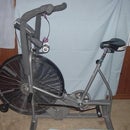Introduction: Technivorm Metering Wedge
The switch settings on the Technivorm basket don’t allow for metering the flow of coffee out of the basket. My experience is that it either pours through or overflows. Pouring through is actually the preferable outcome, bad coffee but easy cleanup. Overflowing stops up the drain hole with grounds so it doesn’t drain and overflows grounds into the carafe. You are left with bad coffee and a hot mess.
Many years ago, I made a “prototype” two-sided wedge to slide in under the switch and allow finer control of the flow of coffee out of the basket. It is a Shredded Wheat box (pressboard) dissected and laminated with rubber cement. After a decade, the end that bumps into the basket has delaminated slightly and it looks quite ratty, though it still works.
I decided to make a new one and document the process. Pressboard works just fine and since it is slightly “fuzzy”, it stays where you set it. Rubber cement is good for laminating prototypes, you can peel off layers of pressboard after the cement has set to get to what works. The pressboard is what you usually throw away; cereal boxes, the backing on ruled pads, the stiffener when you get stamps in the mail, or tucked into "Do Not Bend" envelopes.
Two stepped prototypes were built to test out the flow versus lift and different materials. One was pressboard and the other styrene. The styrene was more slippery and I didn’t like it as well. Wood, FIMO, aluminum, etc. could be used but you would need to experiment to find the surface finish that allows the balance between sliding the wedge and it holding position. A meteor chunk for the high end user? A carbon fiber composite for the “cutting edge” user? A Basilisk fang for the Potter follower? An injection molded, mass produced, "Technimeter"?
The fixed dimensional constraints are 1/2-inch width and 3/4-inch depth. The overall length of 1-1/8-inches was chosen to leave enough sticking out to grab easily but not so much that it would over–balance the wedge. On my basket, it went from a trickle (overflow condition) to gushing (dishwater condition) in 0.1-inches (2.5 mm) of lift. The height range for my basket is 0.215-inches to 0.315 inches (about a 5 mm to 8 mm ramp). A small amount of lift creates a big amount of change in the flow.
The original is a two sided wedge. However, a single-sided wedge was selected to allow for finer control. Pressboard was laminated to get to 0.315-inches and the ramp filed from the front edge to about 3/8-inch from the back edge. Sand paper also works for cutting the ramp. Trying to cut it with a utility knife was uncontrolled and should only be used to remove bulk before filing.
Since they are cheap and quick to make, I would go straight to making the ramp and fine tuning it with the file.
Step 1: Parts, Tools, and Disclaimer
Parts
Paperboard (the back of writing pads, cereal boxes. Etc.)
Glue (Rubber cement, white glue, etc.)
Tools
Scissors, paper cutter, etc.
File or sand paper
Calipers (measuring tool) or two dimes and two pennies stacked (about 0.215-inches) and four quarters and a penny stacked (about 0.315-inches), leaf gauges, etc.
Note: The approximate thickness of; pennies - 0.057, nickels - 0.073, dimes – 0.054”, quarters - 0.067”, and dollar bills – 0.004”
Note: The paper cutter is a Fiskars 12-inch paper cutter. It works very well for paper engineering and styrene sheet scoring.
Disclaimer
I like this disclaimer from the author Samuel M. Goldwasser (http://www.repairfaq.org/sam/captest.htm) - “We will not be responsible for damage to equipment, your ego, blown parts, county wide power outages, spontaneously generated mini (or larger) black holes, planetary disruptions, or personal injury that may result from the use of this material.”
Add to that the usual admonitions to use safety equipment, be careful of hot, sharp, or rotating parts and equipment, and be cautious around electricity. Also, if you change it, and they can tell, it probably voids your warranty.
Step 2: Assembly
Top - Original metering wedge
Left / Right Center - Metering test wedges
Bottom - New metering wedge
- Determine the thickness of your material
- Cut enough 1/2-inch x 1-1/8-inch pieces to build up to about 0.315-inches
- Glue the pieces and let dry
- File or sand a ramp from the leading edge to about 3/8-inch from the back edge. Continue until the front edge is about 0.215-inches thick.
- Test it and adjust as needed.
Step 3: Red Oak Wedge
I decided to try out cutting a wood wedge. I had a length of 1" x 2" (3/4" x 1-1/2" actual) red oak. I cut six blanks and turned one into a wedge. Including photos, it took less than 30 minutes. That is actually faster than the pressboard wedge.
I did "cheat" a little, I used a wood rasp which removes wood very quickly and finished up with a file. Wood rasps are handy tools to own, see "3 Rasps Give You Superpowers". I also would have spent a little more time on a "presentation" wedge and some Minwax to dress it up. And, yes, I used a hacksaw. It makes a finer cut than any of my other saws and doesn't tear the wood.
I tried out the oak wedge and I still like pressboard best.













